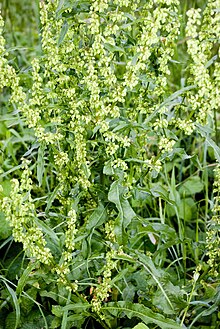Rumex crispus
| Rumex crispus | |
|---|---|
 |
|
| Scientific classification | |
| Kingdom: | Plantae |
| (unranked): | Angiosperms |
| (unranked): | Eudicots |
| (unranked): | Core eudicots |
| Order: | Caryophyllales |
| Family: | Polygonaceae |
| Genus: | Rumex |
| Species: | R. crispus |
| Binomial name | |
|
Rumex crispus L. |
|
Rumex crispus, the curly dock,curled dock or yellow dock, is a perennial flowering plant in the family Polygonaceae, native to Europe and Western Asia.
The plant produces an inflorescence or flower stalk that grows to about 1 m high. It has smooth leaves shooting off from a large basal rosette, with distinctive waved or curled edges. On the stalk flowers and seeds are produced in clusters on branched stems, with the largest cluster being found at the apex. The seeds are shiny, brown and encased in the calyx of the flower that produced them. This casing enables the seeds to float on water and get caught in wool and animal fur, and this helps the seeds to spread to new locations. The root-structure is a large, yellow, forking taproot.
Rumex crispus has a number of subspecies with distinctive habitat preferences. Rumex crispus ssp. crispus occurs on waste and cultivated ground. Rumex crispus ssp. littoreus has a coastal distribution, and Rumex crispus ssp. uliginosus occurs on tidal estuarine mud. The species hybridizes readily with other Rumex species including Rumex obtusifolius, Rumex obovatus, Rumex palustris and Rumex maritimus.
Curly dock grows in a wide variety of habitats, including disturbed soil, waste areas, roadsides, fields/meadows, shorelines, and forest edges. It is widely naturalised throughout the temperate world and has become a serious invasive species in many areas, including throughout North America, southern South America, New Zealand and parts of Australia. It spreads through the seeds contaminating crop seeds, and sticking to clothing. It is classified as an "injurious weed" under the UK Weeds Act 1959. It is often seen in disturbed soils at the edges of roadsides, railway beds, and car parks.
...
Wikipedia
